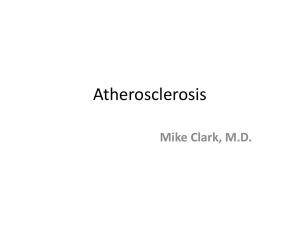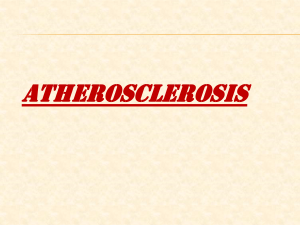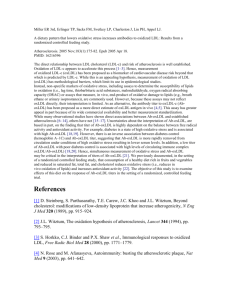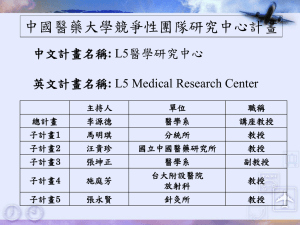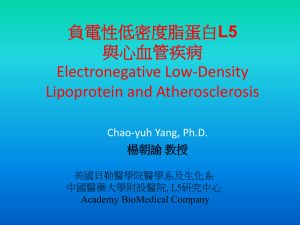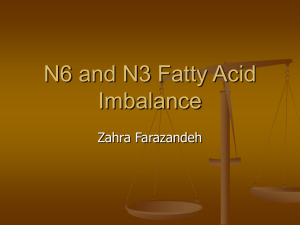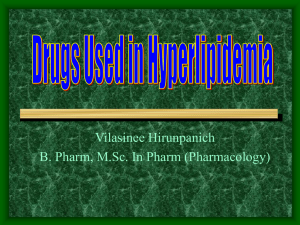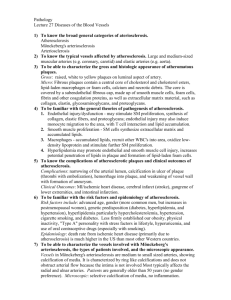J.Frostegård, 2012 Immunity, atherosclerosis and cardiovascular
advertisement
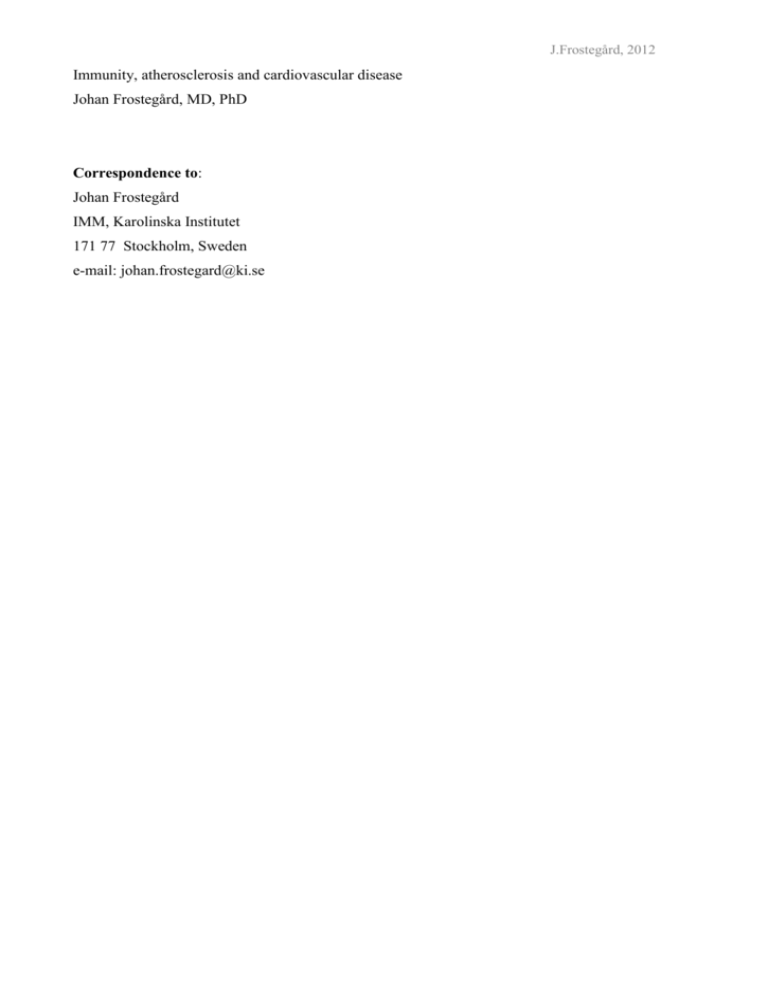
J.Frostegård, 2012 Immunity, atherosclerosis and cardiovascular disease Johan Frostegård, MD, PhD Correspondence to: Johan Frostegård IMM, Karolinska Institutet 171 77 Stockholm, Sweden e-mail: johan.frostegard@ki.se J.Frostegård, 2012 Abstract Atherosclerosis is the major cause of cardiovascular disease (CVD), and thus a dominating cause of mortality and morbidity world wide. Atherosclerosis is a chronic inflammatory condition in the intima of many large and middle sized arteries, where immune competent cells are present, producing mainly pro-inflammatory cytokines. Dead cells, many of which are macrophage-derived foam cells, and oxidized forms of low density lipoproteins (oxLDL) are abundant in lesions. Even though narrowing of arteries by atherosclerosis can play a clinical role, the major cause of CVD appears to be rupture of atherosclerotic plaques. The cause of the inflammation in atherosclerosis is not fully known, and different non-mutually exclusive possibilities exist. oxLDL has proinflammatory and immune stimulatory properties, and causes cell death at higher concentrations, and is one obvious candidate, though also other forms of enzymatically modified LDL could be of importance. One common proinflammatory agent in oxLDL is inflammatory phospholipids, with phosphorylcholine (PC) as the an interesting compound. In support of this, antibodies against PC (anti-PC) are antiatherogenic in mouse studies, and anti-PC is negatively associated with disease development. Various bacteria and virus have been discussed, but it has been difficult to find direct evidence, and antibiotic trials have not been successful. Heat shock protens (HSP) could be one major target for atherogenic immune reactions. More direct causes of plaque rupture include cytokines as IL-1ß and TNF, but also lipid mediators as leukotrienes. To prove that inflammation is a cause of atherosclerosis and CVD, studies with antiinflammatory and/or immune-modulatory treatment are needed. Here we review the potential causes of inflammation in atherosclerosis and discuss how inflammation can be targeted therapeutically to provide novel treatments for cardiovascular disease. J.Frostegård, 2012 Background Atherosclerosis is the dominating cause of cardiovascular disease (CVD) including myocardial infarction (MI), heart failure, stroke, and claudication. Atherosclerosis is located in the intima of many middle sized and large arteries, especially where the vessels divide. Most likely, the nature of the blood flow influences, since areas exposed to normal shear stress seem to be protected; here endothelial cells express atheroprotective genes[1]. Activated endothelium with expression of adhesion molecules appears to be an early event of atherosclerosis, allowing mononuclear leukocytes as monocytes and T-cells to attach to the endothelium and penetrate into the intima. Though not so common as these cells, also dendritic cells, mast cells and a few neutrophils and B-cell may be present in lesions. Another cell type which is present in lesions is smooth muscle cells (SMC) which change phenotype into synthetic SMC, and migrate into the intima from the media. The notion of atherosclerosis as an inflammatory disease is based on the finding that immune competent cells are abundant in atherosclerotic lesions, and also are producing cytokines, especially proinflammatory cytokines[2]. Even though atherosclerosis per se could decrease blood flow through stenosis and thus induce CVD, the major mechanism appears to be atherothrombosis, usually when plaques are damaged, through effects of proinflammatory cytokines and chemokines on the fibrous cap. When plaques are damaged and rupture, prothrombotic material is exposed to the coagulation system, with ensuing inhibition of blood flow and thus induction of CVD. The major risk factors which can be modified for atherosclerosis (and CVD) are hypertension, smoking, diabetes and dyslipidemia. In addition, age and male sex are of major importance[3]. Potential causes of inflammation and immune reactions in atherosclerosis. Oxidized LDL and related compounds Present at an early stage is low density lipoprotein (LDL) modified by oxidation or enzymatic modification. Low density lipoprotein (LDL) penetrates into the intima at the earliest stages of atherosclerosis, binds to the proteoglycan matrix, enabling further modification through oxidation and/or enzymatic modification (OxLDL)[4, 5]. OxLDL is immunogenic and activates endothelial cells, monocytes/macrophages and T cells[6-8]. Further, oxLDL is toxic at higher concentrations and could thus be a cause of cell death in lesions[6-8]. Enzymatically modified LDL could play a major role, and PLA2, which causes such modification, is expressed in both normal arteries and atherosclerotic lesions[9] and can induce activation of dendritic cells[10]. The proinflammatory and immune stimulatory effects of oxLDL are mimicked by inflammatory phoshpolipids such as lysophosphatidylcholine (LPC), which is a major phospholipid in atherosclerotic lesions[11, 12]. Other proinflammatory phospholipids implicated in oxLDL, like LPC, have phosphorylcholine J.Frostegård, 2012 (PC) as an important epitope, which cause these different phospholipids, to different degrees, to interact with the platelet activating factor (PAF)-receptor, which is one mechanism by which oxLDL exerts its effects[13, 14]. Other mechanisms include interaction with Toll-like receptors and scavenger receptors[15, 16]. Not only oxidized and/or enzymatically modified phospholipids are implicated as causes of oxLDL:s pro-atherogenic and pro-inflammatory effects and there are several other possibilities. It has even been suggested that epitopes as those exposed during LDL-modification and/or oxidation represent an evolutionary conserved system of danger associated molecular patterns (DAMP) in parallell with pathogen associated molecular patterns (PAMP)[16]. One important example of DAMP in addition to PL-related epitopes as PC, is Malone-dialdehyde (MDA) which is generated during oxidation of LDL, and MDA forms adducts on proteins and peptides, carbohydrates and DNA[16]. Also modified and oxidized apoB and cholesterol could be implicated[16] though putative mechanisms are not as well described as for PC-exposing epitopes. While lots of evidence from epidemiological studies indicate that smoking is associated with atherosclerosis and CVD[17, 18], the exact mechanisms by which smoking could cause inflammation in the arteries are not fully elucidated, though increased oxidation of lipids is one interesting possibility[19]. Interestingly, smoking is associated with increased lipid oxidation[19]. Different animal models of smoking and atherosclerosis indicate that smoking promotes atherogenesis[20-22], and one underlying mechanism is reported to be oxidative stress[23]. In support of inflammatory phospholipids as causes of atherosclerosis is also data from clinical studies, where we reported that in conditions with increased atheroslerosis, such as hypertension[24], and SLE[25], PC-exposing LDL is increased. Oxidation of LDL, and also increased oxidative stress in diabetes could promote atherogenesis[26]. Formation of advanced glycation end products (AGEs) could contribute to atherosclerosis (and CVD) in diabetes since AGEs have proinflammatory and potentially atherogenic properties [27-29] Phospholipid-related epitopes Antibodies against phospholipids (aPL), especially against cardiolipin (aCL) are well known to be associated with CVD, especially in SLE patients, but it has been difficult to find unequivocal evidence of aPL as atherogenic and and there are both negative and positive reports [30]. In a recent study, we did not find an association between aPL and prevalence of atheroslerotic plaques in patients with SLE [31]. Typical of pathogenic aPL is that they are dependent on plasma co-factors as beta2-Glycoprotein I to promote CVD, mechanisms could include a direct effect on endothelium, and also interference with anti-coagulant proteins such as Annexin A5 [31, 32]. J.Frostegård, 2012 CL has a unique double structure, with four fatty acid chains and is present in in bacteria and the inner mitochondrial membrane of euraryotic cells [33], which is interesting since mitochondria apparently have a bacterial origin [34]. In contrast to aCL, we recently reported that antibodies against oxidized forms of CL (aOxCL) are negatively associated with CVD, low levels giving high risk and high levels low risk[35]. In contrast to aCL, aOxCL are not beta2GPI-dependent[35]. One mechanism could be inhibition of binding and uptake of oxLDL in macrophages[35]. Further, aOxCL and also antibodies against oxidized phosphatidylserine (aOxPS) are negatively associated with atherosclerosis development (unpublished data). Another example of natural antibodies are those against PC (anti-PC). Several lines of evidence imply that anti-PC could play a role in atherogenesis, both from animal studies, other experimental studies and from clinical cohort studies[36]. Immunization in a mouse model with pneumococcae caused a decrease in atherosclerosis development in parallell with an increase in anti-PC levels, among other antibodies[37]. Both passive and active immunization with PC ameliorates atherosclerosis in mouse models[38, 39]. We have reported in several papers where IgM anti-PC are negatively associated with atherosclerosis development and risk of CVD, typically low levels give rise to increased risk and in some cases, also high levels were associated with decreased risk[36] and we reported for the first time that anti-PC is a protection marker for atherosclerosis development in humans which was also the case with anti-MDALDL and anti-OxLDL [40]. Mechanisms by which human anti-PC could ameliorate atherosclerosis and CVD include: antiinflammatory effects, inhibiting pro-inflammatory effects by inflammatory phospholipids[41], inhibition of uptake of oxLDL through scavenger receptors[42] and inhibition of cell death induced by lysophosphatidylcholine, a major inflammatory phospholipid[43]. In another paper, the inflammatory effect of anti-PC is also confirmed, in a mouse model, where facilitating phagocytosis was described as one mechanism. It is possible that natural IgM such as anti-PC could counter atherosclerosis development by binding to dead and dying cells in the lesions, increasing phagocytosis and clearance of obnoxious pro-inflammatory compounds. [44]. Low levels of anti-PC could thus be a cause of the inflammation in atherosclerosis, though it is less clear by what mechanisms. We have suggested that a Western life style could contribute, and one underlying factor could be some types of infections which are not prevalent in the West[45, 46]; another could be factors which are relatively new from an evolutionary point of view such as gluten[47]. Genetic factors could also contribute, in addition to environmental influence since heretability of anti-PC is 37%[48]. Heat shock proteins J.Frostegård, 2012 Heat shock proteins, (HSPs), especially HSP60 but potentially also other ones as HSP70 and HSP90 represent another interesting potential cause of inflammation in atherosclerosis. This could be of great interest since HSPs are immunogenic and T-cell clones recognizing HSP60 are present in both early and late atherosclerotic plaques [49, 50]. HSPs may also activate immune reactions through cross-reactivity with HSP from microorganisms as bacteria. This notion is supported by both clinical data with associations between antibodies against HSP60/65 and atherosclerosis, and experimental data where immunisation with HSP 60/65 aggravates atherosclerosis [51, 52]. HSPs could promote inflammation by other mechanisms as well. Besides being specific T-cell antigens per se, presented on antigen presenting cells, HSP and/or peptides thereof could promote immune activation by other mechanisms. HSP are chaperones and can form immune complexes with other antigens including tumor-derived, and these can be presented through class I or class II antigen presenting pathways[53]. HSP can be passively released which may occur in cell necrosis but also actively through exosomes. HSPs could thus play a role also in the extracellular space where they could be endogenous ligands, activating the innate immune system, through Toll-like receptors or by association with endotoxin[54]. The mechanisms by which hypertension could cause inflammation in the artery wall are not clear. One possibility is a direct effect on the endothelium, which could become dysfunctional as a response to injury leading to proinflammatory changes[55]. We suggested in previous studies that hypertension could cause inflammation by induction of immunogenic heat shock proteins 60/65 (HSP), which are also induced by oxLDL[56, 57]. We reported that HSP70 is a protection factor for development of atherosclerosis among hypertensives, but a putative underlaying mechanism is not clear[58]. Infections Infections have been much discussed as potential causes of immune activation and inflammation in atherosclerosis. In early studies, before the rise of the lipid hypothesis, pathologists and others who observed the lesions thought they could be of infectious origin based on the microscopic and macroscopic features of atherosclerosis. Among the most promising candidates which are present in plaques, promote atherosclerosis in animal studies and have associations with disease in humans are Chlamydia Pneumoniae (CP); periodontal organisms including P Gingivalis (PG) and Aggregatibacter actinomycetemcomitans (AA); Helicobacter Pyloris (HP); Cytomegalovirus (CVM)[59]. One important starting point underlaying the hypotehsis that infections play a role in atherosclerosis was early studies of Chlamydia Pneumoniae (CP), demonstrating presence of this pathogen in atherosclerotic plaques[60] and an association between cardiovascular and antibody titer[61-63] by J.Frostegård, 2012 P Saikku and coworkers and others. Like the case with other pathogens, also discussed, as cytomegalovirus, there are also studies where no such associations were demonstrated[59]. A more formal test of the hypothesis has been done, with treatment with antibiotics which has an effect on CP. However, four large studies where not positive and did not support the notion of a causative effect of CP on CVD[64, 65] [66]. However, there could be other reasons for the negative results. One is that chronic CP may be difficult to treat irrespective of CVD; another is that the treatment trial shave been performed on patients with late stage disease, and it is possible that earlier stages would be more responsive[59]. Periodontal microorganisms as PG and AA are also interesting candidates. Even though clinical/epidemiological studies show associations, there are many confounding factors which are difficult to control for, maybe more for these agents than is the case with other pathogens in this context. A recent scientific statement from the American Heart Association supports and independent association between periodontal disease, but available data do not support causation, though intervention does decrease systemic inflammation and improves endothelial function[67]. CMV belongs to the Herpes virus group which is very common in the general population, which makes studies of associations difficult to interpret. There are interesting reports of an association between active CMV infection and transplant complications including vasculopathy[68] and a causal relationship between CMV infection and transplant vascular complications seem to be more plausible than associations with atherosclerosis per se. CMV is reported to be present in atherosclerotic lesions in many but not all studies[59], and, of note, CMV has also been documented in healthy arteries[69] which could also be taken as an indication that CMV may be an innocent bystander. On the other hand, there are interesting properties in CMV which could make it a plausible candidate to be a contributing factor in atherosclerosis. For example, CMV infection induce migration of arterial smooth muscle cells [70]. Helicobacter Pylory, a well known cause of gastritis and gastric ulcer, may also be implicated in CVD and atherosclerosis, though animal experiments are less clear than is the case with CP. Viable bacteria have not been unequivocally demonstrated from lesions. However, there are positive reports of a reduction of CVD after eradication of HP. In contrast to CP, CMV and several other implicated pathogens, HP does not promote a local inflammatory reaction the the same extent as those[59]. Of note, viable HP have not been isolated from atherosclerotic plaques, and mouse experiments have not given any clear indication that HP is a cause of atherosclerosis[71]. Interestingly, treatment regimens for both C. pneumoniae and H. Pylori had a positive effect on clinical CVD events[72]. However, as discussed, larger studies for CP where not successful and are needed also for HP. Other infectious agents that have been discussed and reported as potential causes of CVD and J.Frostegård, 2012 atherosclerosis include HIV, EBV, Influenza, Mycoplasma pneumoniae and Streptococcus pneumoniae. Another interesting case, where there is evidence from human studies, is Borrelia[73], though experimental data or plaque data are not available to the best of my knowledge, However these appear to be less supported by evidence, especially, there is no convincing data from human studies[59]. Taken together, even though the infectious hypothesis in CVD and atherosclerosis has been studied for some decades, there is still relatively little direct though rather much circumstantial evidence of a causative role of infectious agents. Other types of inflammation as a potentially causative role in atherogenesis Even though it remains to be demonstrated that infections play a direct role in atherogenesis, they could still be of great importance indirectly. By being present in lesions, they could stimulate an ongoing inflammatory process, which in the long run may lead to increased atherosclerosis and ensuing CVD. Further, it is possible that the total infectious burden could be a risk factor for increased atherosclerosis and CVD, possibly through promotion of systemic inflammation, platelet aggregation and endothelial dysfunction, which in its turn could influence atherogenesis[59, 74]. Raised levels of C-reactive protein (CRP) has been implicated as a risk marker for atherosclerosis and CVD in many studies, though it is not clear if CRP could play a causative role. Also cytokines as IL-6 raised systemic levels of oxLDL has been implicated in many studies[3]. Another example of an interesting group of inflammatory compounds is lipid mediators as leukotrienes, which are present in advanced atherosclerotic plaques[75, 76]. Another interesting example of indirect effects by other types of inflammation is the relation between chronic inflammatory and autoimmune diseases and atherosclerosis (and CVD). Here the evidence is strongest for the prototypic autoimmune disease systemic lupus erythematosus, SLE where the risk of CVD is very high, according to one report the risk increased 50 times[77] and several other studies have also reported a high risk (though from low levels since young and middle aged women without SLE (or familial hyperlipidemia) very seldom develop CVD, and even less advanced atherosclerosis[30, 78]. Also in RA, an increased prevalence of atherosclerosis has been reported, though the evidence appears less clear than in SLE. Also in other rheumatic diseases, an increasing amount of papers indicate an increased atherogenesis[30, 78], which is confirmed in a recent meta-analysis which demonstrates that rheumatic diseases increase the risk of atherosclerosis [79]. As discussed in a previous Editorial, it is interesting to note that this discussion is not new. Already in the first half of the 19th century, the legendary pathologists Rokitansky and Virchow (the former as the first) reported that atherosclerosis is an inflammatory process[80, 81] though their opinions J.Frostegård, 2012 differed somewhat, since Rokitansky thought inflammation in atherosclerosis was a secondary phenomenon, but Virchow proposed it was a primary factor [80, 81]. Non-traditional risk markers as low anti-PC and inflammation per se appear to play a role, in addition to traditional ones such as hypertension, dyslipidemia and to varying degree, smoking[30, 78]. Though the opinions may differ somewhat as to what comes first in the development of atherosclerosis, it appears likely that different factors could act in concert. It is also possible that there are differences between different individuals, where some may have atherosclerosis with more inflammation than others and it is also possible that infection could play an important role among subgroups of individuals and patients. Is atherosclerosis a disease or a part of normal aging – or both? An interesting question is whether atherosclerosis should be seen as a normal part of human aging, or as a pathological process which could be if not abolished, at least strongly reduced. Risk factors which cannot be modified include age and male sex, as opposed to those which can be favourably modified as hypertension, dyslipidemia, diabetes and smoking. One way to gain further insight into this intriguing question is to study atherosclerosis and CVD in populations living a life closer to the conditions during which humanity evolved. Further, studies of animals could provide important information. Human studies The presence of atherosclerotic lesions in ancient Egyptian mummies was described more than 100 years ago, findings confirmed and extended during recent years; similar findings have been done in mummified bodies from other cultures as well[82]. It appears that these findings are more clear among wealthy individuals, and, interestingly, were present at a relatively early age, since many of the mummies have been in their 40s and 50s when they died. However, the lives of Egyptians in those days was by no means close to the hunter-gatherer culture, which, from an evolutionary point of view, has shaped us. The famous “iceman” (“Ötzi”) found in South Tyrol in the early 90s is of more interest as compared to the abovementioned mummies. He died after being shot by an arrow, causing internal bleeding, 5300 years ago in the Alps. Ötzi had atherosclerosis as determined by arterial calcifications[83]. His last meals consisted of meat (apparently from red deer and ibex) but also cereals[84]. Further, he seems to have been only approximately 45 years old when killed. Ötzi had signs of infection with Borrelia, which has been linked to atherosclerosis[73]. In a recent study his genome has been sequenced, and among other surprising findings is that he had a genetic predisposition for atherosclerosis[85]. It is thus also possible that he was an unusual case when it comes to J.Frostegård, 2012 atherosclerosis, and of course, a single case cannot prove so much though available data are very intriguing, indicating that at least in this individual, atherosclerosis was present at a relatively young age and at least, the finding indicates that atherosclerosis could occur in relatively young persons in a stone age culture. In Kitava, New Guineans living a traditional life as horticulturalists, CVD, and also other conditions like Alzheimer´s diasease and Rheumatic disaease appear to be very rare. This is not likely to simply be explained by a low life expectancy allowing too little time for these conditions to become manifest. The risk factor profile was favourable as compared to Westeners, with good metabolic control, lack of hypertension, somewhat but not strikingly better lipid profile and also higher levels of anti-inflammatory natural antibodies against phosphorylcholine (anti-PC) which appear to have antiatherosclerotic properties. We also reported that among infections studied in this population, and suggested that infection with treponema is associated with the presence of atheroprotective antiPC. It is possible that a low exposure in the west to such pathogens, could contribute to low anti-PC levels, predisposing to western chronic inflammatory conditions like atherosclerosis[46]. In our study on individuals from Kitava (New Guinea), the age span was between 40 and 86, with a mean age of 59.0, and here, traditional risk factors (except smoking!) were very favourable among Kitavans. This study thus lends support to the notion that CVD and atherosclerosis is less advanced in a more natural condition, since risk factor profile in addition to clinical and local reports also point in that direction[86]. However, more studies are needed to firmly establish the human life expectancy among different “natural” populations. Even though further studies of this issue, in other populations could yield more detailed information on atherosclerosis, studies from Kitava thus favour the notion that at least advanced atherosclerosis leading to plaque rupture and CVD is not a normal component of aging, though measurements, for example by use of ultrasound are not available [87]. This notion is supported by reports from hunter-gatherers in Africa, where CVD as a cause of death appears to be low[88]. It is not clear if the relative short life span (for women life expectancy at menopause was approximately 20 years) is caused by marginalization of these peoples in a globalized world and clearly, this makes conclusions of atherosclerosis and CVD more complicated. A recent study of hunter-gatherers (pygmies living in the Cameroon forest) demonstrated lower aortic stiffness in this group[88] , lending support to an atheroprotective role of the hunter-gatherer life style. It cannot be ruled out that low life expectancy among hunter-gatherers ”mask” cvd caused by atherosclerosis, thoug available evidence argues against this being an important factor. The impacts J.Frostegård, 2012 of resource transfers and other forms of cooperation on reducing mortality likely played an important role in selection on post-reproductive lifespan throughout human evolution. Further, menopause is unusual among humans as compared to animals and it is not likely that this does not have an evolutionary cause, the most likely being the grandmother hyppthesis. According to this, the long postreproductive life among humans has given an advantage, because of the unusually long time it takes for humans to be self-sustaining [89]. Studies of the life span of hunter-gatherers are complicated by differences between groups. For example, pygmies are reported to have comparatively short life span as compared to other groups, and they also reach puberty and menarche early[90]. Indirect evidence that life span could have been relatively long (with a high mortality through life) comes from studies indicating that it takes up to 20 years after achieving an adult body size before becoming a proficient hunter[91]. While mortality throughout life apparently is very high among hunter-gatherers, from causes as vioence and wars, accidents and infection, some also reached a high age[92]. It is thus possible that the reported lack of CVD (and conditions as rheumatic diseases and dementia) is related to a short life span among many, not allowing these conditions to develop, but other factors speak against this as a major factor including the abscence of traditional risk factors as hypertension and diabetes. Surprisingly, in a recent report on African Hadza foragers it was demonstrated that average daily energy expenditure of was no different than that of Westerners after controlling for body size[93]. Thus, the notion of a highly mobile life style among humans living an original ”stone age” life style may not hold water and suggest that humans are not by nature very active. Taken together, human studies indicate that atherosclerosis and its complications does not have to be a problem in normal aging up to high age, which would be a hopeful notion, implying that the disease at least could be postponed. Maybe such “natural” atherosclerosis could be compared to cancer of the prostate, where many elderly men have signs of this disease, but will die from other causes. Atherosclerosis and wild animals. Among wild animals, some forms atherosclerosis has been described, as exemplified in studies of elephants. In one very interesting and unique study, almost 500 elephants were studied directly after death. The animals were randomly culled from free-living populations in East Africa as a part of a programme to decrease the elephant population due to expansion of human agricultural activities and to avoid starvation among these animals. The elephant is interesting in this context, since its life span is similar to man. The study found atherosclerosis to be common, with necrosis, lipid accumulation, lymphocytic infiltration and calcification. Intersetingly there were no signs of mural thrombosis or plaque haemorrhage.. (even with lymphocytic infiltration!)[94]. However, the degree J.Frostegård, 2012 to which CVD is a cause of death in elephants is not known. Also among wild baboons, and some other species, atherosclerosis has been detected[95]. This is interesting, since it further advances the possibility that atherosclerosis could be seen as part as normal aging but that complicated lesions, plaque rupture and ensuing thrombosis and CVD, may not be, at least not until very high age. It is interesting to note that atherosclerosis among African Elephants occurs in spite of a diet free of saturated fat. There was no difference between cholesterol levels in elephants with plaques as compared with those without. Further, cholesterol levels were low as compared to humans[96]. Another surprising study from the Animal Kingdom also suggest that the role of LDL and cholesterol in atherogenesis still could be further clarified. Here, brown bears where found to have very high cholesterol levels, , in addition to physical inactivity during hibernation and obesity, with no signs of atherosclerosis. It is interesting to note that primates in captivity have higher cholesterol and LDL-values than free living, but also that the lipids among wild living primates though relatively low still were in the same range as among humans [97] Animal models of atherosclerosis. Animal models have played a very important role in atherosclerosis studies. Even though the mouse dominates, also pigs, non-human primates, and rabbits are used. All models have limitations and one important problem is that it is difficult to mimick the human disease, plaque rupture, leading to CVD. Pigs and non-human primates develop atherosclerotic lesions without genetically based hyperlipidemia, and are relatively similar to humans with respect to blood lipids, immune system and size of arteries. However, they are expensive and experiments take long time. Rabbits develop lesions that appear to be less inflammatory, and often hyperlipidemia is a prerequisite[98]. Mouse models are important tools to study mechanisms and potential treatment in atherosclerosis. or of major importance in atherosclerosis studies. An inherent problem with such models is that the mouse does develop atherosclerosis spontaneously, and its metabolism and blood lipids are different from humans which of course is the case also with life span. To develop atherosclerosis, strong genetic changes must be induced, and the most commonly used mouse models are examples of this, either being LDL-receptor deficient or apoE k/o. There are several variants of this theme, but in common is that they have very high lipid levels in order to get atherosclerosis. Unfortunately, there are no good mouse models, where inflammation is more in focus, and the current models therefore could be argued to mostly illustrate the lipid hypothesis of atherosclerosis. Nevertheless, the available models have yielded important data, and even though it is a potential problem, like in many animal studies, to mimick the human plaque rupture, also such models are under development. [98]. J.Frostegård, 2012 Another problem with the mouse models of atherosclerosis in relation to immunity and inflammation is not only that they do not develop CVD, there are also other major differences. For example, while natural IgM antibodies against oxLDL related epitopes may be high in these models[99], as discussed, low levels are more prevalent among humans who develop atherosclerosis[100]. Another recent example is that in a mouse model of atherosclerosis which was transgenic for human apoB, T-cells were activated by LDL (and apoB) and not by oxLDL, in contrast to the situation in humans where oxLDL was a cause (and specifically we suggested that oxidized but not native phospholipids) was the main players[11, 13, 101-103]. We recently confirmed these previous findings using human T cells and dendritic cells (unpublished observation). It would thus be beneficial if mouse models were developed where the immune system is more like the human in relation to atherosclerosis. Anti-inflammatory and immune modulatory treatment against atherosclerosis and CVD Even though the inflammatory nature of atherosclerosis and thus CVD has been known for a long time, there is no anti-inflammatory or immune modulatory treatment available to ameliorate these diaseses. However, a number of potential therapies have been proposed to target inflammation in CVD. Statins Interestingly, statins, one of the most successful medicines in history from a commercial point of view, and clearly representing also a therapeutic improvement, may work to an unknown extent due to their pleiotropic, especially anti-inflammatory, properties. This effect is a “side-effect” of these inhibitors of HMG CoA reductase, influencing prenylation as one mechanism. further, immunomodulatory effects of statins, directly interfering with MHC class II presentation have been described (). Interestingly, statins have been reported to be beneficial in RA other anti-inflammatory mechanisms could be decreasing LDL- oxidation, and immune modulatory effects, decreasing MHC class 2 interaction with antigen[104]. Interestingly and in line with this, the Jupiter study demonstrated that statin treatment may be beneficial for individuals with raised high sensitivity Creactive protein but normal LDL [105]. In recent review by P Ridker, it is stated that: “it is impossible in any statin trial to establish whether the clinical benefits of treatment are due to LDLreduction alone, to inflammation inhibition, or to a combination of both processes”[106]. It is striking that the possibility is raised that a novel and successful therapy developed to decrease cholesterol and specifically LDL, may work partly or even only, by another mechanism, namely inhibition of inflammation. Anti-inflammatory treatment J.Frostegård, 2012 Other interesting potential therapies include both unspecific and specific approaches. In RA, treatment with Methotrexate weekly is routinely used, with beneficial effects on patients. A recent meta-analysis indicates that the risk of CVD is decreased in patients with RA treated with Methotrexate[107]. Animal studies where Methotrexate dcreases atherogenesis adds support to Methotrexate as a possible anti-inflammatory therapy in CVD[108]. In the Cardiovascular Inflammation Reduction Trial (CIRT) low dose methotrexate (target dose 20 mg/week) is tested for reduction of major CVD events among post-myocardial infarction patients with diabetes or metabolic syndrome[106]. Also initially in RA, treatment with biologics as TNF-inhibitors have proven to be successful, and novel biologics include also inhibitors of other cytokines. However, there are different opinions as to whether biologics as anti-TNF are beneficial from a cardiovascular point of view, though a recent study where decrease of CVD in RA adds support to this possibility[109, 110]. In the Canakinumab Anti-Inflammatory Thrombosis Outcomes Study (CANTOS), interleukin-1β (IL-1β) inhibition can reduce risk of MI, stroke, and cardiovascular death among stable coronary artery disease patients with high risk of CVD due to persistent elevations of CRP (≥ 2 mg/L) [106, 111]. Other potentially interesting treatment moieties include inhibition of inflammatory lipid mediators as PAF[112]. We recently reported that Annexin A5, an anti-thrombotic plasma protein, is antiinflammatory and inhibits atherosclerosis development and also improves endothelial function in a mouse model, and Annexin A5 could thus represent another possible therapy[113]. Likewise, inhibition of phospholipases as lipoprotein associated PLA2 is of interest. inhibition of Lp-PLA(2) activity with darapladib in patients after an acute coronary syndrome are under way[114]. Immune modulatory therapy One example of possible immune modulatory, and thus potential anti-inflammatory treatment against atherosclerosis and/or CVD, is immune therapy against epitopes from oxLDL. In the mid nineties it was demonstrated that immunization with modified forms of LDL ameliorated atherosclerosis[115], which showed for the first time the possibility of ameliorating atherosclerosis by immunization. As discussed, during LDL-oxidation, various chemical moieties are formed, including both fragmented apoB, and oxidized phospholipids. One approach is to target the apoB component, and peptides from apoB with promising immunomodulatory properties have been demonstrated to decrease atherosclerosis development in animal models[116, 117]. However, a recent clinical study did not show any positive effect in humans[118]. The primary endpoint was the relative change in inflammatory activity in an index arterial vessel after twelve weeks, as measured by FDG-PET/CT J.Frostegård, 2012 imaging. Further studies with other end points and by use of other perhaps more established techniques could clarify if this approach could still be promising in humans. Another line of research and potential treatment is based on the phospholipid moiety as a target for treatment, specifically phosphorylcholine (PC). As discussed above, this notion is supported by cohort studies, animal and in vitro experiments[36, 38, 39, 41, 43, 100]. Mechanisms include antiinflammatory[41, 119], inhibition of cell death[43] and decreased uptake of oxLDL in macrophages[100]. . A more unspecific method of immunomodulation is administration of immunoglobulins. This approach has shown promising results in animal studies[120]. Yet another interesting possibility is to ameliorate atherosclerosis by immunomodulation to decrease immune reactions against heat shock proteins (HSP). To the best of my knowledge, HSPimmunization demonstrated for the first time that atherosclerosis can be influenced by immunization, in a study using a rabbit model, such therapy increased atherosclerosis development[51]. Summary and conclusions Taken together, atherosclerosis is the major underlying cause of CVD, which in turn is the major cause of death, at least in the developed world, and also a major cause of morbidity world wide. During recent years, it has become clear that atherosclerosis is a chronic inflammation in large and middle-sized arteries, where activated immune competent cells are abundant. Inflammation could play a major role to trigger plaque rupture which is the immediate cause of CVD. Oxidized and/or modified forms of LDL, infections, heat shock proteins and a more unspecific systemic inflammation are examples of hypotheses of underlying causes of the inflammation in atherosclerosis. Studies of anti-inflammatory and immune modulatory treatment are underway or discussed. Until such treatment studies in humans demonstrate that atherosclerosis is ameliorated, the causative role of inflammation in atherosclerosis remains a hypothesis. References 1. 2. 3. Gimbrone MA, Jr., Topper JN, Nagel T, Anderson KR, Garcia-Cardena G: Endothelial dysfunction, hemodynamic forces, and atherogenesis. Ann N Y Acad Sci 2000, 902:230239; discussion 239-240. Frostegard J, Ulfgren AK, Nyberg P, Hedin U, Swedenborg J, Andersson U, Hansson GK: Cytokine expression in advanced human atherosclerotic plaques: dominance of proinflammatory (Th1) and macrophage-stimulating cytokines. Atherosclerosis 1999, 145:33-43. Libby P, Ridker PM, Hansson GK: Progress and challenges in translating the biology of atherosclerosis. Nature 2011, 473:317-325. J.Frostegård, 2012 4. 5. 6. 7. 8. 9. 10. 11. 12. 13. 14. 15. 16. 17. 18. 19. Camejo G, Lalaguna F, Lopez F, Starosta R: Characterization and properties of a lipoprotein-complexing proteoglycan from human aorta. Atherosclerosis 1980, 35:307320. Tabas I, Williams KJ, Boren J: Subendothelial lipoprotein retention as the initiating process in atherosclerosis: update and therapeutic implications. Circulation 2007, 116:1832-1844. Frostegard J, Nilsson J, Haegerstrand A, Hamsten A, Wigzell H, Gidlund M: Oxidized low density lipoprotein induces differentiation and adhesion of human monocytes and the monocytic cell line U937. Proc Natl Acad Sci U S A 1990, 87:904-908. Frostegard J, Wu R, Giscombe R, Holm G, Lefvert AK, Nilsson J: Induction of T-cell activation by oxidized low density lipoprotein. Arterioscler Thromb 1992, 12:461-467. Berliner JA, Territo MC, Sevanian A, Ramin S, Kim JA, Bamshad B, Esterson M, Fogelman AM: Minimally modified low density lipoprotein stimulates monocyte endothelial interactions. J Clin Invest 1990, 85:1260-1266. Elinder LS, Dumitrescu A, Larsson P, Hedin U, Frostegard J, Claesson HE: Expression of phospholipase A2 isoforms in human normal and atherosclerotic arterial wall. Arterioscler Thromb Vasc Biol 1997, 17:2257-2263. Atout R, Karabina SA, Dollet S, Carreras M, Payre C, Andre P, Lambeau G, Lotteau V, Ninio E, Perrin-Cocon L: Human group X secreted phospholipase A2 induces dendritic cell maturation through lipoprotein-dependent and -independent mechanisms. Atherosclerosis 2012, 222:367-374. Huang YH, Schafer-Elinder L, Wu R, Claesson HE, Frostegard J: Lysophosphatidylcholine (LPC) induces proinflammatory cytokines by a plateletactivating factor (PAF) receptor-dependent mechanism. Clin Exp Immunol 1999, 116:326-331. Goncalves I, Edsfeldt A, Ko NY, Grufman H, Berg K, Bjorkbacka H, Nitulescu M, Persson A, Nilsson M, Prehn C, et al: Evidence supporting a key role of Lp-PLA2-generated lysophosphatidylcholine in human atherosclerotic plaque inflammation. Arterioscler Thromb Vasc Biol 2012, 32:1505-1512. Frostegard J, Huang YH, Ronnelid J, Schafer-Elinder L: Platelet-activating factor and oxidized LDL induce immune activation by a common mechanism. Arterioscler Thromb Vasc Biol 1997, 17:963-968. Watson AD, Leitinger N, Navab M, Faull KF, Horkko S, Witztum JL, Palinski W, Schwenke D, Salomon RG, Sha W, et al: Structural identification by mass spectrometry of oxidized phospholipids in minimally oxidized low density lipoprotein that induce monocyte/endothelial interactions and evidence for their presence in vivo. J Biol Chem 1997, 272:13597-13607. Greig FH, Kennedy S, Spickett CM: Physiological effects of oxidized phospholipids and their cellular signaling mechanisms in inflammation. Free Radic Biol Med 2012, 52:266280. Miller YI, Choi SH, Wiesner P, Fang L, Harkewicz R, Hartvigsen K, Boullier A, Gonen A, Diehl CJ, Que X, et al: Oxidation-specific epitopes are danger-associated molecular patterns recognized by pattern recognition receptors of innate immunity. Circ Res 2011, 108:235-248. Yusuf S, Hawken S, Ounpuu S, Dans T, Avezum A, Lanas F, McQueen M, Budaj A, Pais P, Varigos J, Lisheng L: Effect of potentially modifiable risk factors associated with myocardial infarction in 52 countries (the INTERHEART study): case-control study. Lancet 2004, 364:937-952. Yanbaeva DG, Dentener MA, Creutzberg EC, Wesseling G, Wouters EF: Systemic effects of smoking. Chest 2007, 131:1557-1566. Morrow JD, Frei B, Longmire AW, Gaziano JM, Lynch SM, Shyr Y, Strauss WE, Oates JA, Roberts LJ, 2nd: Increase in circulating products of lipid peroxidation (F2-isoprostanes) J.Frostegård, 2012 20. 21. 22. 23. 24. 25. 26. 27. 28. 29. 30. 31. 32. 33. 34. 35. in smokers. Smoking as a cause of oxidative damage. New England Journal of Medicine 1995, 332:1198-1203. Penn A, Snyder CA: Inhalation of sidestream cigarette smoke accelerates development of arteriosclerotic plaques. Circulation 1993, 88:1820-1825. Zhu BQ, Sun YP, Sievers RE, Isenberg WM, Glantz SA, Parmley WW: Passive smoking increases experimental atherosclerosis in cholesterol-fed rabbits. J Am Coll Cardiol 1993, 21:225-232. Gairola CG, Drawdy ML, Block AE, Daugherty A: Sidestream cigarette smoke accelerates atherogenesis in apolipoprotein E-/- mice. Atherosclerosis 2001, 156:49-55. Kunitomo M, Yamaguchi Y, Kagota S, Yoshikawa N, Nakamura K, Shinozuka K: Biochemical evidence of atherosclerosis progression mediated by increased oxidative stress in apolipoprotein E-deficient spontaneously hyperlipidemic mice exposed to chronic cigarette smoke. J Pharmacol Sci 2009, 110:354-361. Frostegard J, Wu R, Lemne C, Thulin T, Witztum JL, de Faire U: Circulating oxidized low-density lipoprotein is increased in hypertension. Clin Sci (Lond) 2003, 105:615-620. Frostegard J, Svenungsson E, Wu R, Gunnarsson I, Lundberg IE, Klareskog L, Horkko S, Witztum JL: Lipid peroxidation is enhanced in patients with systemic lupus erythematosus and is associated with arterial and renal disease manifestations. Arthritis Rheum 2005, 52:192-200. Dimitriadis E, Griffin M, Owens D, Johnson A, Collins P, Tomkin GH: Oxidation of lowdensity lipoprotein in NIDDM: its relationship to fatty acid composition. Diabetologia 1995, 38:1300-1306. Beckman JA, Goldfine AB, Gordon MB, Creager MA: Ascorbate restores endotheliumdependent vasodilation impaired by acute hyperglycemia in humans. Circulation 2001, 103:1618-1623. Nishikawa T, Edelstein D, Du XL, Yamagishi S, Matsumura T, Kaneda Y, Yorek MA, Beebe D, Oates PJ, Hammes HP, et al: Normalizing mitochondrial superoxide production blocks three pathways of hyperglycaemic damage. Nature 2000, 404:787790. Laursen JB, Somers M, Kurz S, McCann L, Warnholtz A, Freeman BA, Tarpey M, Fukai T, Harrison DG: Endothelial regulation of vasomotion in apoE-deficient mice: implications for interactions between peroxynitrite and tetrahydrobiopterin. Circulation 2001, 103:1282-1288. Frostegard J: Atherosclerosis in patients with autoimmune disorders. Arterioscler Thromb Vasc Biol 2005, 25:1776-1785. Anania C, Gustafsson T, Hua X, Su J, Vikstrom M, de Faire U, Heimburger M, Jogestrand T, Frostegard J: Increased prevalence of vulnerable atherosclerotic plaques and low levels of natural IgM antibodies against phosphorylcholine in patients with systemic lupus erythematosus. Arthritis Res Ther 2010, 12:R214. Cederholm A, Svenungsson E, Jensen-Urstad K, Trollmo C, Ulfgren AK, Swedenborg J, Fei GZ, Frostegard J: Decreased binding of annexin v to endothelial cells: a potential mechanism in atherothrombosis of patients with systemic lupus erythematosus. Arterioscler Thromb Vasc Biol 2005, 25:198-203. Paradies G, Petrosillo G, Paradies V, Ruggiero FM: Oxidative stress, mitochondrial bioenergetics, and cardiolipin in aging. Free Radic Biol Med 2010, 48:1286-1295. Martin W, Hoffmeister M, Rotte C, Henze K: An overview of endosymbiotic models for the origins of eukaryotes, their ATP-producing organelles (mitochondria and hydrogenosomes), and their heterotrophic lifestyle. Biol Chem 2001, 382:1521-1539. Su J, Hua X, Vikstrom M, Leander K, Gigante B, Hellenius ML, Faire U, Frostegard J: Low levels of IgM antibodies to oxidized cardiolipin increase and high levels decrease risk of cardiovascular disease among 60-year olds: a prospective study. BMC Cardiovasc Disord 2013, 13:1. J.Frostegård, 2012 36. 37. 38. 39. 40. 41. 42. 43. 44. 45. 46. 47. 48. 49. 50. 51. Frostegard J: Low level natural antibodies against phosphorylcholine: a novel risk marker and potential mechanism in atherosclerosis and cardiovascular disease. Clin Immunol 2010, 134:47-54. Binder CJ, Horkko S, Dewan A, Chang MK, Kieu EP, Goodyear CS, Shaw PX, Palinski W, Witztum JL, Silverman GJ: Pneumococcal vaccination decreases atherosclerotic lesion formation: molecular mimicry between Streptococcus pneumoniae and oxidized LDL. Nat Med 2003, 9:736-743. Faria-Neto JR, Chyu KY, Li X, Dimayuga PC, Ferreira C, Yano J, Cercek B, Shah PK: Passive immunization with monoclonal IgM antibodies against phosphorylcholine reduces accelerated vein graft atherosclerosis in apolipoprotein E-null mice. Atherosclerosis 2006, 189:83-90. Caligiuri G, Khallou-Laschet J, Vandaele M, Gaston AT, Delignat S, Mandet C, Kohler HV, Kaveri SV, Nicoletti A: Phosphorylcholine-targeting immunization reduces atherosclerosis. J Am Coll Cardiol 2007, 50:540-546. Su J, Georgiades A, Wu R, Thulin T, de Faire U, Frostegard J: Antibodies of IgM subclass to phosphorylcholine and oxidized LDL are protective factors for atherosclerosis in patients with hypertension. Atherosclerosis 2006, 188:160-166. Su J, Hua X, Concha H, Svenungsson E, Cederholm A, Frostegard J: Natural antibodies against phosphorylcholine as potential protective factors in SLE. Rheumatology (Oxford) 2008, 47:1144-1150. de Faire U, Frostegard J: Natural antibodies against phosphorylcholine in cardiovascular disease. Ann N Y Acad Sci 2009, 1173:292-300. Fiskesund R, Su J, Viksröm M, Faire Ud, Frostegård J: Phosphorylcholine antibodies of the Group I idiotype inhibit cell death and, at high levels, are strong protection markers for atherosclerosis development, particularly when combined with other antibodies against modified LDL. Results in Immunology 2012. Gronwall C, Vas J, Silverman GJ: Protective Roles of Natural IgM Antibodies. Front Immunol 2012, 3:66. Shapira Y, Katz BS, Gilburd B, Barzilai O, Ram M, Blank M, Lindeberg S, Frostegard J, Anaya JM, Bizzaro N, et al: Geographical Differences in Autoantibodies and Antiinfectious Agents Antibodies Among Healthy Adults. Clin Rev Allergy Immunol 2011. Agmon-Levin N, Bat-sheva PK, Barzilai O, Ram M, Lindeberg S, Frostegard J, Shoenfeld Y: Antitreponemal antibodies leading to autoantibody production and protection from atherosclerosis in Kitavans from Papua New Guinea. Ann N Y Acad Sci 2009, 1173:675682. Elkan AC, Sjoberg B, Kolsrud B, Ringertz B, Hafstrom I, Frostegard J: Gluten-free vegan diet induces decreased LDL and oxidized LDL levels and raised atheroprotective natural antibodies against phosphorylcholine in patients with rheumatoid arthritis: a randomized study. Arthritis Res Ther 2008, 10:R34. Rahman I, Atout R, Pedersen NL, de Faire U, Frostegard J, Ninio E, Bennet AM, Magnusson PK: Genetic and environmental regulation of inflammatory CVD biomarkers Lp-PLA2 and IgM anti-PC. Atherosclerosis 2011, 218:117-122. Rossmann A, Henderson B, Heidecker B, Seiler R, Fraedrich G, Singh M, Parson W, Keller M, Grubeck-Loebenstein B, Wick G: T-cells from advanced atherosclerotic lesions recognize hHSP60 and have a restricted T-cell receptor repertoire. Exp Gerontol 2008, 43:229-237. Knoflach M, Kiechl S, Mayrl B, Kind M, Gaston JS, van der Zee R, Faggionato A, Mayr A, Willeit J, Wick G: T-cell reactivity against HSP60 relates to early but not advanced atherosclerosis. Atherosclerosis 2007, 195:333-338. Xu Q, Dietrich H, Steiner HJ, Gown AM, Schoel B, Mikuz G, Kaufmann SH, Wick G: Induction of arteriosclerosis in normocholesterolemic rabbits by immunization with heat shock protein 65. Arterioscler Thromb 1992, 12:789-799. J.Frostegård, 2012 52. 53. 54. 55. 56. 57. 58. 59. 60. 61. 62. 63. 64. 65. 66. 67. 68. 69. Xu Q, Willeit J, Marosi M, Kleindienst R, Oberhollenzer F, Kiechl S, Stulnig T, Luef G, Wick G: Association of serum antibodies to heat-shock protein 65 with carotid atherosclerosis. Lancet 1993, 341:255-259. Murshid A, Gong J, Calderwood SK: The role of heat shock proteins in antigen cross presentation. Front Immunol 2012, 3:63. Tamura Y, Torigoe T, Kukita K, Saito K, Okuya K, Kutomi G, Hirata K, Sato N: Heatshock proteins as endogenous ligands building a bridge between innate and adaptive immunity. Immunotherapy 2012, 4:841-852. Ross R: Atherosclerosis--an inflammatory disease. N Engl J Med 1999, 340:115-126. Frostegard J, Kjellman B, Gidlund M, Andersson B, Jindal S, Kiessling R: Induction of heat shock protein in monocytic cells by oxidized low density lipoprotein. Atherosclerosis 1996, 121:93-103. Frostegard J, Lemne C, Andersson B, van der Zee R, Kiessling R, de Faire U: Association of serum antibodies to heat-shock protein 65 with borderline hypertension. Hypertension 1997, 29:40-44. Pockley AG, Georgiades A, Thulin T, de Faire U, Frostegard J: Serum heat shock protein 70 levels predict the development of atherosclerosis in subjects with established hypertension. Hypertension 2003, 42:235-238. Rosenfeld ME, Campbell LA: Pathogens and atherosclerosis: update on the potential contribution of multiple infectious organisms to the pathogenesis of atherosclerosis. Thromb Haemost 2011, 106:858-867. Shor A, Kuo CC, Patton DL: Detection of Chlamydia pneumoniae in coronary arterial fatty streaks and atheromatous plaques. S Afr Med J 1992, 82:158-161. Saikku P, Leinonen M, Mattila K, Ekman MR, Nieminen MS, Makela PH, Huttunen JK, Valtonen V: Serological evidence of an association of a novel Chlamydia, TWAR, with chronic coronary heart disease and acute myocardial infarction. Lancet 1988, 2:983986. Puolakkainen M, Kuo CC, Shor A, Wang SP, Grayston JT, Campbell LA: Serological response to Chlamydia pneumoniae in adults with coronary arterial fatty streaks and fibrolipid plaques. J Clin Microbiol 1993, 31:2212-2214. Saikku P, Leinonen M, Tenkanen L, Linnanmaki E, Ekman MR, Manninen V, Manttari M, Frick MH, Huttunen JK: Chronic Chlamydia pneumoniae infection as a risk factor for coronary heart disease in the Helsinki Heart Study. Ann Intern Med 1992, 116:273-278. O'Connor CM, Dunne MW, Pfeffer MA, Muhlestein JB, Yao L, Gupta S, Benner RJ, Fisher MR, Cook TD: Azithromycin for the secondary prevention of coronary heart disease events: the WIZARD study: a randomized controlled trial. Jama 2003, 290:1459-1466. Grayston JT, Kronmal RA, Jackson LA, Parisi AF, Muhlestein JB, Cohen JD, Rogers WJ, Crouse JR, Borrowdale SL, Schron E, Knirsch C: Azithromycin for the secondary prevention of coronary events. New England Journal of Medicine 2005, 352:1637-1645. Cannon CP, Braunwald E, McCabe CH, Grayston JT, Muhlestein B, Giugliano RP, Cairns R, Skene AM: Antibiotic treatment of Chlamydia pneumoniae after acute coronary syndrome. New England Journal of Medicine 2005, 352:1646-1654. Lockhart PB, Bolger AF, Papapanou PN, Osinbowale O, Trevisan M, Levison ME, Taubert KA, Newburger JW, Gornik HL, Gewitz MH, et al: Periodontal disease and atherosclerotic vascular disease: does the evidence support an independent association?: a scientific statement from the American Heart Association. Circulation 2012, 125:2520-2544. Fateh-Moghadam S, Bocksch W, Wessely R, Jager G, Hetzer R, Gawaz M: Cytomegalovirus infection status predicts progression of heart-transplant vasculopathy. Transplantation 2003, 76:1470-1474. Melnick JL, Hu C, Burek J, Adam E, DeBakey ME: Cytomegalovirus DNA in arterial walls of patients with atherosclerosis. J Med Virol 1994, 42:170-174. J.Frostegård, 2012 70. 71. 72. 73. 74. 75. 76. 77. 78. 79. 80. 81. 82. 83. 84. 85. 86. 87. Streblow DN, Soderberg-Naucler C, Vieira J, Smith P, Wakabayashi E, Ruchti F, Mattison K, Altschuler Y, Nelson JA: The human cytomegalovirus chemokine receptor US28 mediates vascular smooth muscle cell migration. Cell 1999, 99:511-520. Mach F, Sukhova GK, Michetti M, Libby P, Michetti P: Influence of Helicobacter pylori infection during atherogenesis in vivo in mice. Circ Res 2002, 90:E1-4. Stone AF, Mendall MA, Kaski JC, Edger TM, Risley P, Poloniecki J, Camm AJ, Northfield TC: Effect of treatment for Chlamydia pneumoniae and Helicobacter pylori on markers of inflammation and cardiac events in patients with acute coronary syndromes: South Thames Trial of Antibiotics in Myocardial Infarction and Unstable Angina (STAMINA). Circulation 2002, 106:1219-1223. Volzke H, Wolff B, Ludemann J, Guertler L, Kramer A, John U, Felix SB: Seropositivity for anti-Borrelia IgG antibody is independently associated with carotid atherosclerosis. Atherosclerosis 2006, 184:108-112. Elkind MS: Infectious burden: a new risk factor and treatment target for atherosclerosis. Infect Disord Drug Targets 2012, 10:84-90. Haeggstrom JZ, Funk CD: Lipoxygenase and leukotriene pathways: biochemistry, biology, and roles in disease. Chem Rev 2011, 111:5866-5898. Qiu H, Gabrielsen A, Agardh HE, Wan M, Wetterholm A, Wong CH, Hedin U, Swedenborg J, Hansson GK, Samuelsson B, et al: Expression of 5-lipoxygenase and leukotriene A4 hydrolase in human atherosclerotic lesions correlates with symptoms of plaque instability. Proc Natl Acad Sci U S A 2006, 103:8161-8166. Manzi S, Meilahn EN, Rairie JE, Conte CG, Medsger TA, Jr., Jansen-McWilliams L, D'Agostino RB, Kuller LH: Age-specific incidence rates of myocardial infarction and angina in women with systemic lupus erythematosus: comparison with the Framingham Study. Am J Epidemiol 1997, 145:408-415. Frostegard J: Cardiovascular co-morbidity in patients with rheumatic diseases. Arthritis Res Ther 2011, 13:225. Tyrrell PN, Beyene J, Feldman BM, McCrindle BW, Silverman ED, Bradley TJ: Rheumatic Disease and Carotid Intima-Media Thickness. A Systematic Review and Meta-Analysis. Arterioscler Thromb Vasc Biol. Mayerl C, Lukasser M, Sedivy R, Niederegger H, Seiler R, Wick G: Atherosclerosis research from past to present--on the track of two pathologists with opposing views, Carl von Rokitansky and Rudolf Virchow. Virchows Arch 2006, 449:96-103. Frostegard J: Rheumatic diseases: insights into inflammation and atherosclerosis. Arterioscler Thromb Vasc Biol 2010, 30:892-893. David AR, Kershaw A, Heagerty A: Atherosclerosis and diet in ancient Egypt. Lancet 2012, 375:718-719. Murphy WA, Jr., Nedden Dz D, Gostner P, Knapp R, Recheis W, Seidler H: The iceman: discovery and imaging. Radiology 2003, 226:614-629. Rollo F, Ubaldi M, Ermini L, Marota I: Otzi's last meals: DNA analysis of the intestinal content of the Neolithic glacier mummy from the Alps. Proc Natl Acad Sci U S A 2002, 99:12594-12599. Keller A, Graefen A, Ball M, Matzas M, Boisguerin V, Maixner F, Leidinger P, Backes C, Khairat R, Forster M, et al: New insights into the Tyrolean Iceman's origin and phenotype as inferred by whole-genome sequencing. Nat Commun 2012, 3:698. Frostegard J, Tao W, Georgiades A, Rastam L, Lindblad U, Lindeberg S: Atheroprotective natural anti-phosphorylcholine antibodies of IgM subclass are decreased in Swedish controls as compared to non-westernized individuals from New Guinea. Nutr Metab (Lond) 2007, 4:7. Lindeberg S, Lundh B: Apparent absence of stroke and ischaemic heart disease in a traditional Melanesian island: a clinical study in Kitava. J Intern Med 1993, 233:269275. J.Frostegård, 2012 88. 89. 90. 91. 92. 93. 94. 95. 96. 97. 98. 99. 100. 101. 102. 103. 104. 105. 106. Lemogoum D, Ngatchou W, Janssen C, Leeman M, Van Bortel L, Boutouyrie P, Degaute JP, Van de Borne P: Effects of hunter-gatherer subsistence mode on arterial distensibility in Cameroonian pygmies. Hypertension 2012, 60:123-128. Gurven M, Stieglitz J, Hooper PL, Gomes C, Kaplan H: From the womb to the tomb: the role of transfers in shaping the evolved human life history. Exp Gerontol 2012, 47:807813. Walker R, Gurven M, Hill K, Migliano A, Chagnon N, De Souza R, Djurovic G, Hames R, Hurtado AM, Kaplan H, et al: Growth rates and life histories in twenty-two small-scale societies. Am J Hum Biol 2006, 18:295-311. Gurven M, Kaplan H, Gutierrez M: How long does it take to become a proficient hunter? Implications for the evolution of extended development and long life span. J Hum Evol 2006, 51:454-470. Burger O, Baudisch A, Vaupel JW: Human mortality improvement in evolutionary context. Proc Natl Acad Sci U S A 2012, 109:18210-18214. Pontzer H, Raichlen DA, Wood BM, Mabulla AZ, Racette SB, Marlowe FW: Huntergatherer energetics and human obesity. PLoS One 2012, 7:e40503. McCullagh KG: Arteriosclerosis in the African elephant. I. Intimal atherosclerosis and its possible causes. Atherosclerosis 1972, 16:307-335. Howard AN: The baboon in atherosclerosis research: comparison with other species and use in testing drugs affecting lipid metabolism. Adv Exp Med Biol 1976, 67:77-87. Dillman JS, Car WR: Observations on arteriosclerosis, serum cholesterol and serum electrolytes in the wild African elephant (Loxodonta africana). J Comp Pathol 1970, 80:81-87. Schmidt DA, Ellersieck MR, Cranfield MR, Karesh WB: Cholesterol values in freeranging gorillas (Gorilla gorilla gorilla and Gorilla beringei) and Bornean orangutans (Pongo pygmaeus). J Zoo Wildl Med 2006, 37:292-300. Getz GS, Reardon CA: Animal models of atherosclerosis. Arterioscler Thromb Vasc Biol 2012, 32:1104-1115. Tuominen A, Miller YI, Hansen LF, Kesaniemi YA, Witztum JL, Horkko S: A natural antibody to oxidized cardiolipin binds to oxidized low-density lipoprotein, apoptotic cells, and atherosclerotic lesions. Arterioscler Thromb Vasc Biol 2006, 26:2096-2102. de Faire U, Su J, Hua X, Frostegard A, Halldin M, Hellenius ML, Wikstrom M, Dahlbom I, Gronlund H, Frostegard J: Low levels of IgM antibodies to phosphorylcholine predict cardiovascular disease in 60-year old men: effects on uptake of oxidized LDL in macrophages as a potential mechanism. J Autoimmun 2010, 34:73-79. Frostegard J, Wu R, Giscombe R, Holm G, Lefvert AK, Nilsson J: Induction of T-cell activation by oxidized low density lipoprotein. Arterioscler Thromb 1992, 12:461-467. Fei GZ, Huang YH, Swedenborg J, Frostegard J: Oxidised LDL modulates immuneactivation by an IL-12 dependent mechanism. Atherosclerosis 2003, 169:77-85. Stemme S, Faber B, Holm J, Wiklund O, Witztum JL, Hansson GK: T lymphocytes from human atherosclerotic plaques recognize oxidized low density lipoprotein. Proc Natl Acad Sci U S A 1995, 92:3893-3897. Wang CY, Liu PY, Liao JK: Pleiotropic effects of statin therapy: molecular mechanisms and clinical results. Trends Mol Med 2008, 14:37-44. Ridker PM, Danielson E, Fonseca FA, Genest J, Gotto AM, Jr., Kastelein JJ, Koenig W, Libby P, Lorenzatti AJ, MacFadyen JG, et al: Rosuvastatin to prevent vascular events in men and women with elevated C-reactive protein. New England Journal of Medicine 2008, 359:2195-2207. Ridker PM: Moving Beyond JUPITER: Will Inhibiting Inflammation Reduce Vascular Event Rates? Curr Atheroscler Rep 2013, 15:295. J.Frostegård, 2012 107. 108. 109. 110. 111. 112. 113. 114. 115. 116. 117. 118. 119. 120. Micha R, Imamura F, Wyler von Ballmoos M, Solomon DH, Hernan MA, Ridker PM, Mozaffarian D: Systematic review and meta-analysis of methotrexate use and risk of cardiovascular disease. Am J Cardiol 2011, 108:1362-1370. Bulgarelli A, Martins Dias AA, Caramelli B, Maranhao RC: Treatment with methotrexate inhibits atherogenesis in cholesterol-fed rabbits. J Cardiovasc Pharmacol 2012, 59:308314. Krishnan E, Lingala VB, Singh G: Declines in mortality from acute myocardial infarction in successive incidence and birth cohorts of patients with rheumatoid arthritis. Circulation 2004, 110:1774-1779. Bernatsky S, Hudson M, Suissa S: Anti-rheumatic drug use and risk of hospitalization for congestive heart failure in rheumatoid arthritis. Rheumatology (Oxford) 2005, 44:677-680. Qamar A, Rader DJ: Effect of interleukin 1beta inhibition in cardiovascular disease. Curr Opin Lipidol 2012, 23:548-553. Subbanagounder G, Leitinger N, Shih PT, Faull KF, Berliner JA: Evidence that phospholipid oxidation products and/or platelet-activating factor play an important role in early atherogenesis : in vitro and In vivo inhibition by WEB 2086. Circ Res 1999, 85:311-318. Ewing MM, de Vries MR, Nordzell M, Pettersson K, de Boer HC, van Zonneveld AJ, Frostegard J, Jukema JW, Quax PH: Annexin A5 therapy attenuates vascular inflammation and remodeling and improves endothelial function in mice. Arterioscler Thromb Vasc Biol 2011, 31:95-101. O'Donoghue ML, Braunwald E, White HD, Serruys P, Steg PG, Hochman J, Maggioni AP, Bode C, Weaver D, Johnson JL, et al: Study design and rationale for the Stabilization of pLaques usIng Darapladib-Thrombolysis in Myocardial Infarction (SOLID-TIMI 52) trial in patients after an acute coronary syndrome. Am Heart J 2011, 162:613-619 e611. Palinski W, Miller E, Witztum JL: Immunization of low density lipoprotein (LDL) receptor-deficient rabbits with homologous malondialdehyde-modified LDL reduces atherogenesis. Proc Natl Acad Sci U S A 1995, 92:821-825. Fredrikson GN, Soderberg I, Lindholm M, Dimayuga P, Chyu KY, Shah PK, Nilsson J: Inhibition of atherosclerosis in apoE-null mice by immunization with apoB-100 peptide sequences. Arterioscler Thromb Vasc Biol 2003, 23:879-884. Strom A, Fredrikson GN, Schiopu A, Ljungcrantz I, Soderberg I, Jansson B, Carlsson R, Hultgardh-Nilsson A, Nilsson J: Inhibition of injury-induced arterial remodelling and carotid atherosclerosis by recombinant human antibodies against aldehyde-modified apoB-100. Atherosclerosis 2007, 190:298-305. http://www.news-medical.net/news/20120711/BioInvent-announces-data-from-BI-204phase-IIa-study-on-stable-atherosclerotic-vascular-disease.aspx: 2012. Chen Y, Khanna S, Goodyear CS, Park YB, Raz E, Thiel S, Gronwall C, Vas J, Boyle DL, Corr M, et al: Regulation of dendritic cells and macrophages by an anti-apoptotic cell natural antibody that suppresses TLR responses and inhibits inflammatory arthritis. J Immunol 2009, 183:1346-1359. Nicoletti A, Kaveri S, Caligiuri G, Bariety J, Hansson GK: Immunoglobulin treatment reduces atherosclerosis in apo E knockout mice. J Clin Invest 1998, 102:910-918.
